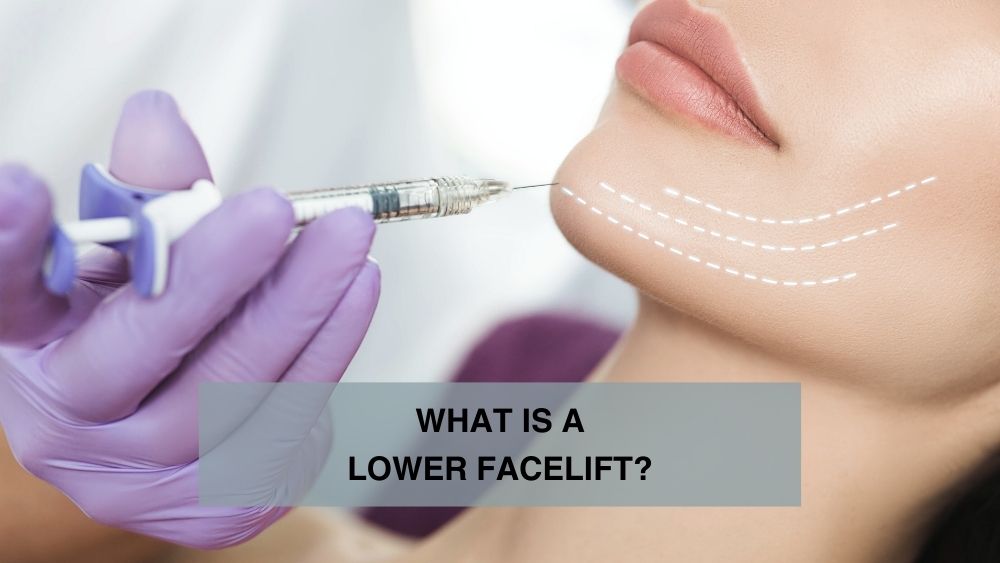What Is a Lower Facelift?

As we age, often the first signs of aging appear on the face and neck. When serums, injectables, and other topical solutions don’t work to improve these aging signs, many patients naturally turn to facelift surgery.
With that said, a simple search of facelift before and after photos will quickly show you that there are actually several different types of facelift surgery to choose from. As you approach your procedure, it’s important that you know about the four main types: lower facelift surgery, mid facelift surgery, upper facelift surgery, and mini facelift surgery.
In this article, we’ll be discussing lower facelift surgery.
Table of Contents
ToggleLower Facelift Overview
A lower facelift targets the bottom third of the face — typically from the upper lip and downward. This tends to be an area where most people have the most excess skin, sagging skin, wrinkles, and “trouble areas”. Patients are often unhappy with their jowls, wrinkles on the sides of their mouth, and loose skin on the neck.
Who Is a Good Candidate for Lower Facelift Surgery?
The best candidate for lower facelift surgery is someone who struggles with signs of aging on the lower third of their face. A lower facelift uses surgical techniques that can remove excess skin, lift sagging skin, and smooth out deep wrinkles for a more youthful appearance.
Patients should be non-smokers, in good physical health, and without any major medical concerns. Having skin laxity (poor skin elasticity) is okay for facelift surgery as facial rejuvenation will address this issue.
Note that a traditional facelift tends to address signs of aging on the lower and mid face, as well as on the neck. While a lower facelift will target the neck somewhat, a traditional facelift surgery focuses on a larger area. A mini facelift procedure does not cover as much area, and there are fewer incisions.
Lower Facelift Procedure
Anesthesia is the first step, followed by small incisions around the ears. The skin and underlying tissue will be lifted. New sutures will be placed. Excess skin will be pulled gently back, and the incisions will be carefully closed.
Lower Facelift Recovery
The initial lower facelift recovery period will last one to two weeks. Take it easy during this time, and do not strain your body in any way. Avoid heavy lifting.
Consume a healthy diet along with plenty of water. Sleep on your back with your upper body slightly lifted to help reduce fluid buildup and swelling. Check out neck lift lower facelift recovery pictures day by day for more details on the recovery experience.
Lower Facelift Before and After FAQs
Does lower facelift surgery hurt?
There’s no need to worry about the facelift surgery itself being painful. Facelift surgery is typically performed under general anesthesia, so you will be asleep during the procedure and will not feel any pain.
It is normal to feel some soreness and slight discomfort in the days following surgery. Most patients feel this pain peaks around day two or three and goes down from there.
Fortunately, you will have taken off work and will be able to stay at home and rest during this time. Your plastic surgeon will also make prescription pain medication available to help ease your discomfort at this time.
How much does a lower facelift cost?
Your lower facelift cost can vary drastically depending on the scope of your particular procedure. Different patients require different techniques to be used to correct their areas of concern.
Furthermore, plastic surgeons charge different rates for their work. Some plastic surgeons may specialize in facial plastic surgery. Therefore, they may be more in demand, and their prices may reflect that.
Other variables include geographic location, type of anesthesia required for surgery, and surgical facility or hospital costs.
Will a lower facelift leave scars?
Most patients will not end up with noticeable lower facelift scars. This is because the best facelift surgeon will be sure to position each facelift incision in a hard-to-see location.
Most incisions are placed around the ear and within the hairline and sideburn area. These areas camouflage scars very well because the hair grows over many of the incision sites, and we can also place incisions just within the ear, within creases around the ear, and behind the ear.
Lastly, your body will heal your scars naturally, and with time, they will fade together with the surrounding skin.
Lower Facelift Before and After
Set Up a Consultation Today
Facelift surgery techniques have advanced to such a degree today that most people can’t tell at all when someone has had a facelift. In fact, many celebrities have undergone this procedure and you would never know it. The same likely goes for some people you personally know.
If you have been considering facelift surgery for yourself and you think a lower facelift may suit you, please get in touch. Board-certified plastic surgeon Dr. Rachel Mason would be more than happy to tell you more about the procedure and discuss your goals with you.
Let’s find out if you’d be a good candidate for a lower facelift. Call today to request a consultation appointment with Dr. Mason.


